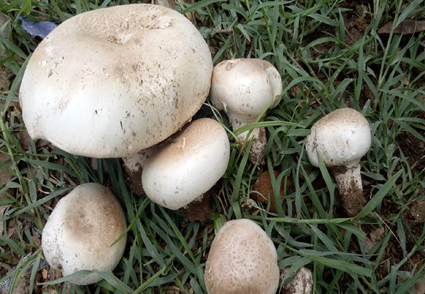Abstract
There are around 500 species of saprobic basidiomycetes in the genus Agaricus, of which 21 are reported from Pakistan. In this study, Agaricus karakensis sp. nov. is described as a new species from the tropical semi-arid District Karak, Khyber Pakhtunkhwa, Pakistan. The taxonomic identification was based on morphological features and ITS-region of rDNA. Both, field data and morpho-anatomical characterizations support that our specimens belong to a new species of Agaricus section Bivelares from family Agaricaceae, order Agaricales. In the phylogenetic tree, A. karakensis fall in section Bivelares forming a sister branch with A. bitorquis. In this paper, the nearest falling species were also compared with our novel finding in morphology.
References
- Callac, P. & Chen, J. (2018) Tropical species of Agaricus. Updates on tropical mushrooms. Basic and applied research. San Cristobal de Las Cascaas. Chiapas 25–38.
- Camelini, C.M., Gomes, A., Cardozo, F.T.G.S., Simoes, C.M.O., Rossi, M.J., Giachini, A.J., Petrus, J.C.C. & de Mendonça, M.M. (2013) Production of polysaccharide from Agaricus subrufescens Peck on solid-state fermentation. Applied microbiology and biotechnology 97 (1): 123–133. https://doi.org/10.1007/s00253-012-4281-z
- El Sheikha, A.F. & Hu, D.M. (2018) How to trace the geographic origin of mushrooms?. Trends in Food Science & Technology 78: 292–303. https://doi.org/10.1016/j.tifs.2018.06.008
- Chen, J., Callac, P., Parra, L.A., Karunarathna, S.C., He, M.Q., Moinard, M., Kesel, A.De., Raspe, O., Wisitrassameewong, K., Hyde, K.D. & Zhao, R.L. (2017) Study in Agaricus subgenus Minores and allied clades reveals a new American subgenus and contrasting phylogenetic patterns in Europe and Greater Mekong Subregion. Persoonia: Molecular Phylogeny and Evolution of Fungi 38: 170–196. https://doi.org/10.3767/003158517X695521
- De Silva, D.D., Rapior, S., Fons, F., Bahkali, A.H. & Hyde, K.D. (2012) Medicinal mushrooms in supportive cancer therapies: an approach to anti-cancer effects and putative mechanisms of action. Fungal Diversity 55 (1): 1–35. https://doi.org/10.1007/s13225-012-0151-3
- Dentinger, B.T., Didukh, M.Y. & Moncalvo, J.M. (2011) Comparing COI and ITS as DNA barcode markers for mushrooms and allies (Agaricomycotina). PLoS ONE 6 (9): e25081. https://doi.org/10.1371/journal.pone.0025081
- Dui, K.D.H. & Zhao, R. (2015) Edible species of Agaricus (Agaricaceae) from Xinjiang Province (Western China). Phytotaxa 202 (3): 185–197. https://doi.org/10.11646/phytotaxa.202.3.2
- Gui, Y., Zhu, G.S., Callac, P., Hyde, K.D., Parra, L.A., Chen, J., Yang, T., Huang, W., Gong, G. & Liu, Z.Y. (2015) Agaricus section Arvenses: three new species in highland subtropical Southwest China. Fungal biology 119 (2–3): 79–94. https://doi.org/10.1016/j.funbio.2014.10.005
- He, M.Q., Chuankid, B., Hyde, K.D., Cheewangkoon, R. & Zhao, R.L. (2018) A new section and species of Agaricus subgenus Pseudochitonia from Thailand. MycoKeys 40: 53–67. https://doi.org/10.3897/mycokeys.40.26918
- Horton, T.R. & Bruns, T.D. (2001) The molecular revolution in ectomycorrhizal ecology: peeking into the black‐box. Molecular ecology 10 (8): 1855–1871. https://doi.org/10.1046/j.0962-1083.2001.01333.x
- Karunarathna, S.C., Chen, J., Mortimer, P.E., Xu, J.C., Zhao, R.L., Callac, P. & Hyde, K.D. (2016) A review of genus Agaricus in tropical and humid subtropical regions of Asia. Mycosphere Journal 7 (4): 417–439. https://doi.org/10.5943/mycosphere/7/4/3
- Kerrigan, R.W. (2016) Agaricus of North America. New York Botanical Garden.
- Kerrigan, R.W., Callac, P. & Parra, L.A. (2008) New and rare taxa in Agaricus section Bivelares (Duploannulati). Mycologia 100 (6): 876–892. https://doi.org/10.3852/08-019
- Khan, M., Hussain, F. and Musharaf, S. (2011) Preliminary floristic range of Tehsil Takht-e-Nasrati Pakistan. Intern, Journal of Biosciences 1 (6): 88–99.
- Khan, M., Hussain, F. & Musharaf, S. (2013) Ethnobotanical profile of Tehsil Takht-e-Nasratti, District Karak, Pakistan. Journal of Medicinal Plants Research 7 (22): 1636–1651
- Lebel, T. (2013) Two new species of sequestrate Agaricus (section Minores) from Australia. Mycological progress 12 (4): 699–707. https://doi.org/10.1007/s11557-012-0879-x
- Khan, M. & Hussain, F. (2012) Palatability and animal preferences of plants in Tehsil Takht-e-Nasrati, District Karak, Pakistan. African Journal of Agricultural Research 7 (44): 5858–5872. https://doi.org/10.5897/AJAR12.2095
- Li, S.F., Xi, Y.L., Qi, C.X., Liang, Q.Q., Wei, S.L., Li, G.J., Zhao, O., Lia, S.J. & Wenb, H.A. (2014) Agaricus taeniatus sp. nov., a new member of Agaricus sect. Bivelares from northwest China. Mycotaxon 129 (1): 187–196. https://doi.org/10.5248/129.187
- Mitchell, A.D. & Walter, M. (1999) Species of Agaricus occurring in New Zealand. New Zealand Journal of Botany 3 (4): 715–725. https://doi.org/10.1080/0028825X.1999.9512665
- Peay, K.G., Schubert, M.G., Nguyen, N.H. & Bruns, T.D. (2012) Measuring ectomycorrhizal fungal dispersal: macroecological patterns driven by microscopic propagules. Molecular Ecology 21 (16): 4122–4136. https://doi.org/10.1007/978-3-642-36821-9_1
- Savoie, J.M., Foulongne-Oriol, M., Barroso, G. & Callac, P. (2013) 1 genetics and genomics of cultivated mushrooms, application to breeding of Agarics. Agricultural applications: 3–33. https://doi.org/10.1093/molbev/msr121
- Tamura, K., Peterson, D., Peterson, N., Stecher, G., Nei, M. & Kumar, S. (2011) MEGA5: molecular evolutionary genetics analysis using maximum likelihood, evolutionary distance, and maximum parsimony methods. Molecular biology and evolution 28 (10): 2731–2739.
- Thawthong, A., Karunarathna, S.C., Thongklang, N., Chukeatirote, E., Kakumyan, P., Chamyuang, S., Rizal, L.M., Mortimer, P.E., Xu, J., Callac, P. & Hyde, K.D. (2014) Discovering and domesticating wild tropical cultivatable mushrooms. Chiang Mai Journal of Science 41 (4): 731–764.
- Ullah, T., Saba, M. & Syed, M.F. (2022) Coprinopsis afrocinerea (Agaricales, Psathyrellaceae): First record from Asia (Pakistan). Microscopy Research and Technique 85 (10): 3374–3381. https://doi.org/10.1002/jemt.24192
- Ullah, T., Ullah, K., Saba, M. & Shah, F.H. (2023) Conocybe karakensis sp. nov. (Bolbitiaceae, Agaricales) from Pakistan. Phytotaxa 584 (3): 135–48. https://doi.org/10.11646/phytotaxa.584.3.1
- Zhang, M.Z., Li, G.J., Dai, R.C., Xi, Y.L., Wei, S.L. & Zhao, R.L. (2017) The edible wide mushrooms of Agaricus section Bivelares from Western China. Mycosphere 8 (10): 1640–1652. https://doi.org/10.5943/mycosphere/8/10/4
- Zhao, R.L., Zhou, J.L., Chen, J., Margaritescu, S., Sanchez, R.S., Hyde, K.D., Callac, P., Parra, L.A., Li, G.J. & Moncalvo, J.M. (2016) Towards standardizing taxonomic ranks using divergence times a case study for reconstruction of the Agaricus taxonomic system. Fungal diversity 78 (1): 239–292. https://doi.org/10.1007/s13225-016-0357-x
- Zhao, R., Karunarathna, S., Raspe, O., Parra, L.A., Guinberteau, J., Moinard, M., Kesel, A.D., Barroso, G., Courtecuisse, R., Hyde, K.D., Guelly, A.K., Desjardin, D.E. & Callac, P. (2011) Major clades in tropical Agaricus. Fungal Diversity 51 (1): 279–296. https://doi.org/10.1007/s13225-011-0136-7


